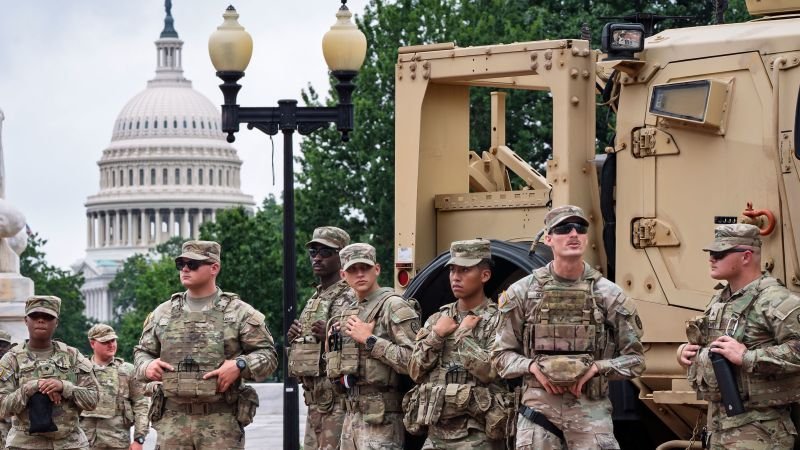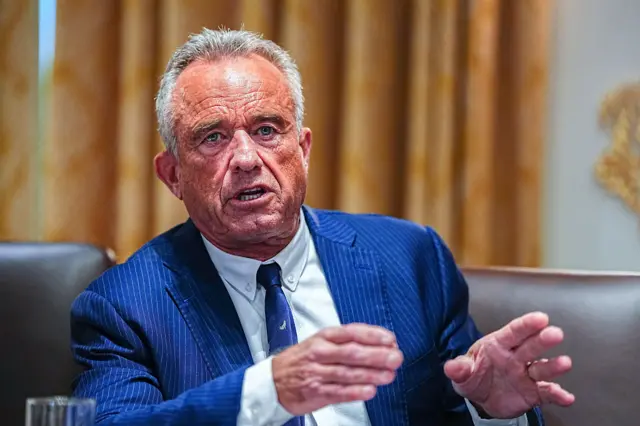Washington, DC, officials are suing the Trump administration, accusing the president of violating the Constitution and federal law by sending thousands of National Guard troops into the city without consent from local leaders.
The lawsuit, filed Thursday by DC Attorney General Brian Schwalb, claims the troops – many from out of state – have been deputized by the US Marshals office and are patrolling neighborhoods, conducting searches and making arrests, despite federal laws that generally bar the military from acting as local police.
The lawsuit argues that the deployment undermines the city’s autonomy, erodes trust between residents and law enforcement and damages the local economy by discouraging tourism and hurting businesses.
“Deploying the National Guard to engage in law enforcement is not only unnecessary and unwanted, but it is also dangerous and harmful to the District and its residents,” Schwalb said in a statement. “It’s DC today but could be any other city tomorrow. We’ve filed this action to put an end to this illegal federal overreach.”
President Donald Trump rolled out the deployment of troops on August 11 as part of his anti-crime agenda in the nation’s capital, which has also included a surge in federal officers from other agencies and an attempted takeover of the city’s police department.
In the weeks since, National Guard members in DC, which include troops from six GOP-led states, have been ordered to carry weapons. As of Tuesday morning, there were 2,290 National Guard troops assigned to the mission – 1,340 of them from supporting states.
The city, the lawsuit reads, “has suffered a severe and irreparable sovereign injury from the deployment.”
“No American jurisdiction should be involuntarily subjected to military occupation,” reads the complaint, filed in the US District Court for DC. “The District of Columbia brings this lawsuit to obtain declaratory and injunctive relief that will stop Defendants’ violations of law, remedy the harms Defendants are inflicting on the District, and preserve the District’s sovereignty.”
CNN reported earlier this week that National Guard members deployed in DC are expected to have their military orders extended through December to ensure troop benefits.
The Trump administration has touted its efforts in the capital city, pointing to a sharp drop in violent crime since ramping up federal law enforcement last month. But critics — including DC Mayor Muriel Bowser — argue the National Guard deployment is unnecessary and costly, with taxpayers footing an estimated $1 million a day, while troops are seen taking photos with tourists, picking up trash, and laying mulch.
Bowser issued an executive order this week requiring the city to closely coordinate with federal law enforcement indefinitely. While some progressive groups viewed the move as ceding to Trump, Bowser later clarified that the order was designed to provide a pathway for the district to exit the federal emergency by offering the administration and congressional Republicans an off-ramp to scale back their involvement in DC.
“I want the message to be clear to the Congress: We have a framework to request or use federal resources in our city. We don’t need a presidential emergency,” Bowser said Wednesday, emphasizing that protecting DC’s autonomy remains her “north star.”
The lawsuit comes as the Trump administration prepares for a major immigration enforcement operation in Chicago, with Trump pledging to send in National Guard troops, though he has not given a timeline.
While the administration looks to replicate its efforts in other Democratic-led cities – Trump holds unique authority over the DC National Guard, which reports only to the President of the United States. The city’s status as a district — not a state — allows the president and the federal government more leeway in directing troops and a range of federal authorities.
The DC attorney general’s lawsuit comes after another challenge to Trump’s deployment of the National Guard proved successful earlier this week in California.
A federal judge ruled Tuesday that Trump and Defense Secretary Pete Hegseth violated federal law by using the US military to help carry out law enforcement activities in and around Los Angeles earlier this summer.
In June, Trump ordered 2,000 National Guard troops and hundreds of Marines into Los Angeles – over the objection of the state’s Democratic Gov. Gavin Newsom – to quell immigration protests.
Schwalb sued the Trump administration last month after Attorney General Pam Bondi attempted to appoint an emergency police commissioner to replace DC’s police chief and take over the department’s operations. Ultimately, Trump officials backed down from that sweeping takeover but still maintain the ability to request any services from the local police department as part of the federal emergency, which expires next week unless Congress extends it.
House Republicans are currently weighing legislation that would overhaul criminal justice policies in DC and oust the locally elected Schwalb, replacing him with a presidential appointee.
This week, Schwalb announced he will run for reelection.



























